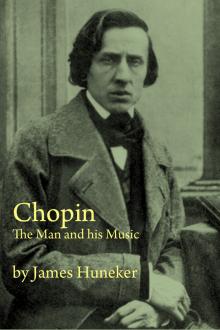Chopin: The Man and His Music, James Huneker [free e books to read online txt] 📗

- Author: James Huneker
- Performer: -
Book online «Chopin: The Man and His Music, James Huneker [free e books to read online txt] 📗». Author James Huneker
Therefore the picture of the Grafin Potocka in the Berlin gallery is not that of Chopin’s devoted friend.
Here is another Count Tarnowski story. It touches on a Potocka episode.
“Chopin liked and knew how to express individual characteristics on the piano. Just as there formerly was a rather widely-known fashion of describing dispositions and characters in so-called ‘portraits,’ which gave to ready wits a scope for parading their knowledge of people and their sharpness of observation; so he often amused himself by playing such musical portraits. Without saying whom he had in his thoughts, he illustrated the characters of a few or of several people present in the room, and illustrated them so clearly and so delicately that the listeners could always guess correctly who was intended, and admired the resemblance of the portrait. One little anecdote is related in connection with this which throws some light on his wit, and a little pinch of sarcasm in it.
“During the time of Chopin’s greatest brilliancy and popularity, in the year 1835, he once played his musical portraits in a certain Polish salon, where the three daughters of the house were the stars of the evening. After a few portraits had been extemporized, one of these ladies wished to have hers—Mme. Delphine Potocka. Chopin, in reply, drew her shawl from her shoulders, threw it on the keyboard and began to play, implying in this two things; first, that he knew the character of the brilliant and famous queen of fashion so well, that by heart and in the dark he was able to depict it; secondly, that this character and this soul is hidden under habits, ornamentations and decorations of an elegant worldly life, through the symbol of elegance and fashion of that day, as the tones of the piano through the shawl.”
Because Chopin did not label his works with any but general titles, Ballades, Scherzi, Studies, Preludes and the like, his music sounds all the better: the listener is not pinned down to any precise mood, the music being allowed to work its particular charm without the aid of literary crutches for unimaginative minds. Dr. Niecks gives specimens of what the ingenious publisher, without a sense of humor, did with some of Chopin’s compositions: Adieu a Varsovie, so was named the Rondo, op. 1; Hommage a Mozart, the Variations, op. 2; La Gaite, Introduction and Polonaise, op. 3 for piano and ‘cello; La Posiana—what a name!—the Rondo a la Mazur, op. 5; Murmures de la Seine, Nocturnes op. 9; Les Zephirs, Nocturnes, op. 15; Invitation a la Valse, Valse, op. 18; Souvenir d’Andalousie, Bolero, op. 19—a bolero which sounds Polish!—Le Banquet Infernal, the First Scherzo, op.
20—what a misnomer!—Ballade ohne Worte, the G minor Ballade—there is a polyglot mess for you!—Les Plaintives, Nocturnes, op. 27; La Meditation, Second Scherzo, B flat minor-meditation it is not!—II Lamento e la Consolazione, Nocturnes, op. 32; Les Soupirs, Nocturnes, op. 37, and Les Favorites, Polonaises, op. 40. The C minor Polonaise of this opus was never, is not now, a favorite. The mazurkas generally received the title of Souvenir de la Pologne.
In commemoration of the fiftieth anniversary of the death of Chopin, October 17, 1899, a medal was struck at Warsaw, bearing on one side an artistically executed profile of the Polish composer. On the reverse, the design represents a lyre, surrounded by a laurel branch, and having engraved upon it the opening bars of the Mazurka in A flat major. The name of the great composer with the dates of his birth and death, are given in the margin. Paderewski is heading a movement to remove from Paris to Warsaw the ashes of the pianist, but it is doubtful if it can be managed. Paris will certainly object to losing the bones of such a genius.
Chopin’s acoustic parallelisms are not so concrete, so vivid as Wagner’s. Nor are they so theatrical, so obvious. It does not, however, require much fancy to conjure up “the drums and tramplings of three conquests” in the Eroica Polonaise or the F sharp major Impromptu. The rhythms of the Cradle Song and the Barcarolle are suggestive enough and if you please there are dew-drops in his cadenzas and there is the whistling of the wind in the last A minor Study. Of the A flat Study Chopin said: “Imagine a little shepherd who takes refuge in a peaceful grotto from an approaching storm. In the distance rushes the wind and the rain, while the shepherd gently plays a melody on his flute.” This is quoted by Kleczynski. There are word-whisperings in the next study in F minor, whilst the symbolism of the dance—the Valse, Mazurka, Polonaise, Menuetto, Bolero, Schottische, Krakowiak and Tarantella—is admirably indicated in all of them. The bells of the Funeral March, the will o’ wisp character of the last movement of the B flat minor Sonata, the dainty Butterfly Study in G flat, opus 25, the aeolian murmurs of the E flat Study, in opus 10, the tiny prancing silvery hoofs in the F
major Study, opus 25, the flickering flame-like C major Study No. 7, opus 10, the spinning in the D flat Valse and the cyclonic rush of chromatic double notes in the E flat minor Scherzo—these are not studied imitations but spontaneous transpositions to the ideal plane of primary, natural phenomena.
Chopin’s system—if it be a system—of cadenzas, fioriture embellishment and ornamentation is perhaps traceable to the East. In his “Folk Music Studies,” Mr. H. E. Krehbiel quotes the description of “a rhapsodical embellishment, called ‘alap,’ which after going through a variety of ad libitum passages, rejoins the melody with as much grace as if it had never been disunited, the musical accompaniment all the while keeping time. These passages are not reckoned essential to the melody, but are considered only as grace notes introduced according to the fancy of the singer, when the only limitations by which the performer is bound are the notes peculiar to that particular melody and a strict regard to time.”
Chopin founded no school, although the possibilities of the piano were canalized by him. In playing, as in composition, only the broad trend of his discoveries may be followed, for his was a manner not a method.
He has had for followers Liszt, Rubinstein, Mikuli, Zarembski, Nowakowski, Xaver Scharwenka, Saint-Saens, Scholtz, Heller, Nicode, Moriz Moszkowski, Paderewski, Stojowski, Arenski, Leschetizki, the two Wieniawskis, and a whole group of the younger Russians Liadoff, Scriabine and the rest. Even Brahms—in his F sharp major Sonata and E
flat minor Scherzo—shows Chopin’s influence. Indeed but for Chopin much modern music would not exist.
But a genuine school exists not. Henselt was only a German who fell asleep and dreamed of Chopin. To a Thalberg-ian euphony he has added a technical figuration not unlike Chopin’s, and a spirit quite Teutonic in its sentimentality. Rubinstein calls Chopin the exhalation of the third epoch in art. He certainly closed one. With a less strong rhythmic impulse and formal sense Chopin’s music would have degenerated into mere overperfumed impressionism. The French piano school of his day, indeed of today, is entirely drowned by its devotion to cold decoration, to unemotional ornamentation. Mannerisms he had—what great artist has not?—but the Greek in him, as in Heine, kept him from formlessness. He is seldom a landscapist, but he can handle his brush deftly before nature if he must. He paints atmosphere, the open air at eventide, with consummate skill, and for playing fantastic tricks on your nerves in the depiction of the superhuman he has a peculiar faculty. Remember that in Chopin’s early days the Byronic pose, the grandiose and the horrible prevailed—witness the pictures of Ingres and Delacroix—and Richter wrote with his heart-strings saturated in moonshine and tears. Chopin did not altogether escape the artistic vices of his generation. As a man he was a bit of poseur—the little whisker grown on one side of his face, the side which he turned to his audience, is a note of foppery—but was ever a detester of the sham-artistic. He was sincere, and his survival, when nearly all of Mendelssohn, much of Schumann and half of Berlioz have suffered an eclipse, is proof positive of his vitality. The fruit of his experimentings in tonality we see in the whole latter-day school of piano, dramatic and orchestral composers. That Chopin may lead to the development and adoption of the new enharmonic scales, the “Homotonic scales,” I do not know. For these M. A. de Bertha claimed the future of music. He wrote:
“Now vaporously illumined by the crepuscular light of a magical sky on the boundaries of the major and minor modes, now seeming to spring from the bowels of the earth with sepulchral inflexions, melody moves with ease on the serried degrees of the enharmonic scales. Lively or slow she always assumed in them the accents of a fatalist impossibility, for the laws of arithmetic have preceded her, and there still remains, as it were, an atmosphere of proud rigidity. Melancholy or passionate she preserves the reflected lines of a primitive rusticity, which clings to the homotones in despite of their artificial origin.” But all this will be in the days to come when the flat keyboard will be superseded by a Janko many-banked clavier contrivance, when Mr. Krehbiel’s oriental srootis are in use and Mr. Apthorp’s nullitonic order, no key at all, is invented. Then too a new Chopin may be born, but I doubt it.
Despite his idiomatic treatment of the piano it must be remembered that Chopin under Sontag’s and Paganini’s influence imitated both voice and violin on the keyboard. His lyricism is most human, while the portamento, the slides, trills and indescribably subtle turns—are they not of the violin? Wagner said to Mr. Dannreuther—see Finck’s “Wagner and his Works”—that “Mozart’s music and Mozart’s orchestra are a perfect match; an equally perfect balance exists between Palestrina’s choir and Palestrina’s counterpoint, and I find a similar correspondence between Chopin’s piano and some of his Etudes and Preludes—I do not care for the Ladies’ Chopin; there is too much of the Parisian salon in that, but he has given us many things which are above the salon.” Which latter statement is slightly condescending.
Recollect, however, Chopin’s calm depreciation of Schumann. Mr. John F.
Runciman, the English critic, asserts that “Chopin





Comments (0)